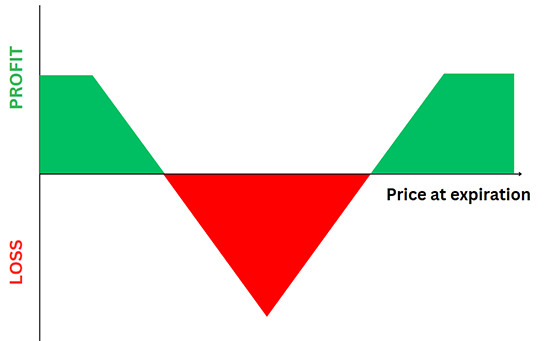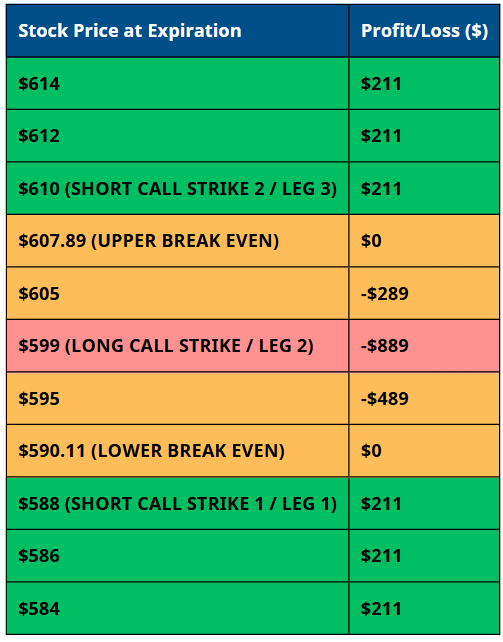Short Call Butterfly Option Screener
Short Call Butterfly Option Screener
Hi, and welcome to the Options Learning Center. I'm going to show you how to sell short call butterflies and use Barchart to get the most out of the strategy.
What Is A Short Call Butterfly Spread?
The short call butterfly spread is a directional options strategy involving four call options, two of which are at the same strike price, on the same underlying asset, and with the same expiration date. This strategy works best if you anticipate the asset will trade with higher volatility by expiration. For example, you might trade this strategy before a big announcement or an earnings release. The trade will hit the maximum profit condition if the underlying asset's trading price ends outside the outer strike prices.

Short Butterfly Spread Options Strategy:
- Combines Four Call Options
- Same Underlying Asset and Expiration
- Profit: Underlying Trades Beyond Outer Strikes
- Result: Bull Call & Bear Call Spread
- Max Profit: Net Credit Received
- Loss: Asset Price Ends at the Middle Strike
To set up the trade, you'll sell one call at a lower strike, buy two calls at a middle strike, and sell one at a higher strike. All options share the same underlying asset and expiration date, with strike prices equally spaced.
Short Call Butterfly
- Sell One Call (lowest strike price)
- Buy Two Calls (higher strike price)
- Sell One Call (highest strike price)
The result is a bull call and bear call spread that results in a net credit.
The goal of a short call butterfly is to achieve maximum profit, and it'll happen if the underlying asset's price trades outside the short strike prices at expiration. The maximum loss occurs if the asset price settles at the middle strike price at expiration.
Trade Examples
Now, let me show you how you can find short call butterflies.
Screening The Market For Short Call Butterfly Trades
To access the Short Call Butterfly screener, go to Barchart.com, click on the Options tab, and then click on Short Call Butterfly Screener. you'll be taken to the results page, where you will immediately see the short call butterfly trades. Here, you'll find essential trade details like expiration dates, strike prices, premiums, max profits and losses, and the probability of loss.
These default results are already in their maximum profit condition, as the underlying security price is currently below the lower short strike. The probability of loss is also low.
Now, you can also rearrange the columns by clicking on any heading. For instance, I'll click on a couple of headers here to sort them from highest to lowest or vice versa.
If you want to adjust the search parameters, click “Set Filters” at the top, which will take you to the options screener page.
On the screener page, you can type your desired filter into the “Add Filter” field and click “Add.” If you're unsure what to add, click the dropdown and select an option. Available filters cover stock and options data, including options analysis, underlying prices, trade details, company earnings, and technicals—everything you need to fine-tune your trade is right here.
You can also remove any filters you don't need. The rest of the values appear by default and serve as a starting point, but you can adjust them. For example, I'll add ETF to the Security Type here. Then, let's scroll down to the Probability of Loss.
As the name implies, this filter shows the likelihood of losing on the trade by at least 1 cent, which to me, is arguably the most essential filter. So, for illustration, I'll set this to 20% or less. Now, I'll click on See Results. And here we go!
Now, I'll sort the risk/reward column from lowest to highest. And so, I'll go with the top one here.
Now before I explain the trade, let me show you how you can save your screener to reuse it later. Just click Save Screener near the top right, then type in the screener's name. At the bottom, you can also have Barchart email you at a specified time with your trades. It's that easy. Now that's done, let's move on to the trade example.


According to the screener, you can set up a short call butterfly spread on SPY, with the ETF currently trading at $580.01. Here's how this trade works: you start by selling the $588-strike call, collecting a premium of $7.37 per share. Then, you buy two $599-strike calls, paying $3.16 per share for each contract. Finally, you sell the $610-strike call, collecting $1.06 per share.
This setup results in a total net credit of $2.11 per share, or $211 total for one spread. Your maximum loss on the trade is $8.89 per share. All options expire on November 29, or 29 days remaining until expiration - from the time of recording. The trade has a 19.7% probability of loss.
I find it's best to know the breakeven points on the upside and downside when monitoring the trade. Barchart gives you the breakeven points. But if you want to calculate it yourself, add the net credit to the lower strike to get the downside breakeven. For the upside breakeven, subtract the net credit from the higher strike. That gives you breakeven points of $590.11 on the lower end and $607.89 on the upper end.
Breakeven Calculation
- Lower Breakeven: Lower Short Call Strike + Net Credit
- Upper Breakeven: Higher Short Call Strike - Net Credit
Profit Scenario

If the price of SPY moves beyond the short strike prices in either direction, you get to keep the maximum profit. The maximum profit is calculated by subtracting the premium paid from the premium received to set up the trade, which works out to $2.11 per share or $211 total per contract.
Premiums Received: $7.37 + $1.06 = $8.43
Premiums Paid: $3.16 * 2 = $6.32
Maximum Profit: $8.43 - $6.32 = $2.11 * 100 = $211
Loss Scenario

However, if the price of SPY stays between the short strikes and ends at the long strike instead, you will hit the maximum loss condition. This is calculated by taking the difference between the short strike and either of the long strikes, also known as the width of the spread, and subtracting the credit received. For this trade, that's $8.89 per share or $889 per spread.
Width Of The Spread: $599 - $588 = $11
Net Premium Received: $2.11
Maximum Loss: $11 - 2.11 = $8.89 * 100 = $889
Profit/Loss Across Different Price Points
Here's a profit/loss chart with different prices at expiration to illustrate how short call butterfly trades work.

As you can see, the maximum loss occurs only if SPY trades at exactly $599 at expiration, and transitions from loss to profit as the underlying security moves beyond the break even points. The maximum profit occurs when the underlying security trades beyond the short strikes at expiration.
Screening For Short Call Butterflies For Specific Assets
So that's screening the entire market for assets to use in short call butterfly trades. But what about if you have a specific stock in mind? That's also easy. Let me show you how.
All you need to do is go to the stock or asset's Price Overview page on Barchart.com. Once there, navigate to the left and look for Butterfly spreads. Then, click the short call butterfly tab to see the trade search results.
You can click on the dropdown to change the expiration dates, change trade legs, rearrange each column, or click the screen button then the set filter tab to access the option screener page for a more granular search. It's really that easy.
Closing Your Positions Before Expiration
It is always a good idea to close your positions right before expiration when using any strategy that requires writing or selling options. For this example, you have two short positions in this trade, and if either is in the money at expiration, the option will be automatically exercised, or, in your perspective, you will be assigned.
- Strategy includes two short positions
- ITM option(s) will be exercised at expiration
If either of the short calls get assigned, you are obligated to sell 100 shares of stock for every contract you wrote. This means you might need to purchase the shares at the current market price—which could be higher than the strike price—and then sell them at your strike price, potentially resulting in a loss.
- Assignment means selling 100 shares
- Adverse market conditions could lead to a loss
You may also sell the long call positions to capture any remaining value which will mitigate some of your losses if they haven't expired yet. But keep an eye out for trading fees, as it might not be worth it.
- Sell Long Calls to Capture Any Remaining Value
- Watch Out for Trading Fees
Pros and Cons of Short Call Butterfly Spreads
Short call butterfly spreads require little capital, as they start with a credit. Like all spreads, they have a defined profit/loss profile, making them great for risk-averse traders. Additionally, you don't need to predict which direction the underlying asset will move, since both directions lead to a profit. That makes it excellent for high-volatility trading environments.
Pros of Short Call Butterflies
- Low Capital Requirement
- Defined Profit/Loss
- No Need To Predict Direction
- Profit During High Volatility
The short call butterfly, like all short spreads, has limited profit potential. It can require a significant price movement in the underlying asset, depending on the spread's width. This strategy is also highly sensitive to time decay, especially if the asset's price stays near the long middle strikes. Additionally, transaction costs in multi-legged spreads can reduce profits, so monitoring these costs is essential.
Cons of Short Call Butterflies
- Limited Profit Potential
- Requires Significant Price Movement
- High Sensitivity to Theta Decay
- Higher Transaction Costs
Conclusion
The short call butterfly is an excellent strategy for high-volatility situations where you can't anticipate which direction the asset will move. However, it often requires significant price movement to profit, and its multiple trade legs can lead to high trading costs, further impacting profitability. So, to maximize your strategy and profits, you need to keep a close eye on your trades and use resources such as trade guides and Barchart's option screener. That way, your efforts won't be wasted.
If you need more information, visit the Barchart Options Learning Center where you can learn more about this strategy, as well as other option trading strategies broken down into their working parts, so that you know exactly what you need to trade them.
Back to Top ↑
